In modern times, Saint Petersburg is considered the Northern Capital and serves as a home to some federal government bodies such as the Constitutional Court of Russia and Heraldic Council of the President of the Russian Federation. It is also a seat for National Library of Russia and a planned location for the Supreme Court of the Russian Federation. The Historic Centre of Saint Petersburg and Related Groups of Monuments constitute a UNESCO World Heritage Site, so it's also referred to as Russia's Culture Capital. Saint Petersburg is home to the Hermitage, one of the largest art museums in the world.
Saint Petersburg was a beautiful city planned by Peter I. There are many man-made rivers (or canals) in the city, so the city is sometimes called the Venice of the North. There are also beautiful buildings built by Russian emperors in other places of the city. Some of these buildings are the Hermitage Museum and the Winter Palace.
The elevation of Saint Petersburg ranges from the sea level to its highest point of 175.9 m (577 ft) at the Orekhovaya Hill in the Duderhof Heights in the south. Part of the city's territory west of Liteyny Prospekt is no higher than 4 m (13 ft) above sea level, and has suffered from numerous floods. Floods in Saint Petersburg are triggered by a long wave in the Baltic Sea, caused by meteorological conditions, winds and shallowness of the Neva Bay. The five most disastrous floods occurred in 1824 (4.21 m or 13 ft 10 in above sea level, during which over 300 buildings were destroyed ), 1924 (3.8 m, 12 ft 6 in), 1777 (3.21 m, 10 ft 6 in), 1955 (2.93 m, 9 ft 7 in), and 1975 (2.81 m, 9 ft 3 in). To prevent floods, the Saint Petersburg Dam has been constructed.
Since the 18th century the city's terrain has been raised artificially, at some places by more than 4 m (13 ft), making mergers of several islands, and changing the hydrology of the city. Besides the Neva and its tributaries, other important rivers of the federal subject of Saint Petersburg are Sestra, Okhta and Izhora. The largest lake is Sestroretsky Razliv in the north, followed by Lakhtinsky Razliv, Suzdal Lakes and other smaller lakes.
Saint Petersburg is about 165 km (103 miles) from the border with Finland, connected to it via the M10 highway.
The average maximum temperature in July is 23 °C (73 °F), and the average minimum temperature in February is −8.5 °C (16.7 °F); an extreme temperature of 37.1 °C (98.8 °F) occurred during the 2010 Northern Hemisphere summer heat wave. A winter minimum of −35.9 °C (−32.6 °F) was recorded in 1883. The average annual temperature is 5.8 °C (42.4 °F). The Neva River within the city limits usually freezes up in November–December and break-up occurs in April. From December to March there are 118 days average with snow cover, which reaches an average snow depth of 19 cm (7.5 in) by February. The frost-free period in the city lasts on average for about 135 days. Despite St. Petersburg's northern location, its winters are warmer than Moscow's due to the Gulf of Finland and some Gulf Stream influence from Scandinavian winds that can bring temperature slightly above freezing. The city also has a slightly warmer climate than its suburbs. Weather conditions are quite variable all year round.
Average annual precipitation varies across the city, averaging 660 mm (26 in) per year and reaching maximum in late summer. Soil moisture is almost always high because of lower evapotranspiration due to the cool climate. Air humidity is 78% on average, and there are, on average, 165 overcast days per year.
Toponymy
The first and fairly rich chapter of the history of the local toponymy is the story of the city's name. The name day of Peter I falls on 29 June, when the Russian Orthodox Church observes the memory of Saint Apostles Peter and Paul. The consecration of the small wooden church in their names (its construction began at the same time as the citadel) made them the heavenly patrons of the Peter and Paul Fortress, while St. Peter at the same time became the eponym of the whole city. In June 1703 Peter the Great gave the site the name Sankt Pieter Burkh (an emulation of Dutch topografical suffix -burg, which refers to fortified towns and places, as Peter was a Neerlandophile) which was subsequently russified.
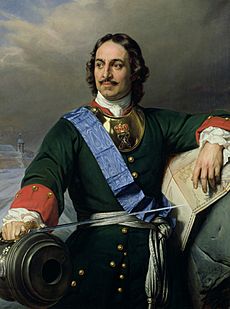
While not originally named for Tsar
Peter the Great, during World War I the city was changed from the Germanic "Peterburg" to "Petrograd" in his honour
A 14- to 15-letter-long name, composed of the three roots proved too cumbersome, and many shortened versions were used. The first General Governor of the city Menshikov is maybe also the author of the first nickname of Petersburg which he called Петри (Petri). It took some years until the known Russian spelling of this name finally settled. In 1740s Mikhail Lomonosov uses a derivative of Greek: Πετρόπολις (Petropolis; Петрополис, Petropolis) in a Russified form Petropol' (Петрополь). A combo Piterpol (Питерпол) also appears at this time. In any case, eventually the usage of prefix "Sankt-" ceased except for the formal official documents, where a three-letter abbreviation "СПб" (SPb) was very widely used as well.
In the 1830s Alexander Pushkin translated the "foreign" city name of "Saint Petersburg" to the more Russian Petrograd in one of his poems. However, it was only on 31 August [O.S. 18 August] 1914, after the war with Germany had begun, that Tsar Nicholas II renamed the capital to Petrograd. Since the prefix "Saint" was omitted, this act also changed the eponym and the "patron" of the city, from Apostle Peter to Peter the Great, its founder.
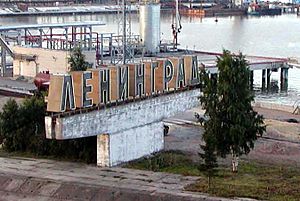
From 1924 to 1991 the city was known as 'Leningrad'. This is a picture of the Saint Petersburg port entrance with an old 'Ленинград' (Leningrad) sign
After the October Revolution the name Red Petrograd (Красный Петроград, Krasny Petrograd) was often used in newspapers and other prints until the city was renamed Leningrad in January 1924.
A referendum on reversing the renaming of Leningrad was held on 12 June 1991, with 54.86% of voters (with a turnout of 65%) supporting "Saint Petersburg". Renaming the city Petrograd was not an option. This change officially took effect on 6 September 1991. Meanwhile, the oblast whose administrative center is also in Saint Petersburg is still named Leningrad.
Having passed the role of capital to Petersburg, Moscow never relinquished the title of "capital", being called pervoprestolnaya ("first-throned") for 200 years. An equivalent name for Petersburg, the "Northern Capital", has re-entered usage today since several federal institutions were recently moved from Moscow to Saint Petersburg. Solemn descriptive names like "the city of three revolutions" and "the cradle of the October revolution" used in Soviet-era are reminders of the pivotal events in national history that occurred here. For their part, poetic names of the city, like the "Venice of the North" and the "Northern Palmyra" emphasize town-planning and architectural features contrasting these parallels to the northern location of this megalopolis. Petropolis is a translation of a city name to Greek, and is also a kind of descriptive name: Πέτρ- is a Greek root for "stone", so the "city from stone" emphasizes the material that had been forcibly made obligatory for construction from the very first years of the city. (Its official Greek name is Αγία Πετρούπολη.)
Demographics
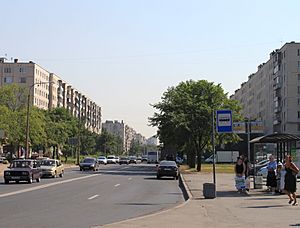
Soviet era apartment buildings in Saint Petersburg, July 2010
Saint Petersburg is the second largest city in Russia. As of the 2017 Rosstat, the federal subject's population is 5,281,579 or 3.6% of the total population of Russia; up from 4,879,566 (3.4%) recorded in the 2010 Census, and up from 5,023,506 recorded in the 1989 Census.
The 2010 Census recorded the ethnic composition as follows: Russian 80.1%, Ukrainian 1.3%, Belarusians 0.8%, Tatar 0.6%, Armenian 0.6%, Jewish 0.5%, Uzbek 0.4%, Tajik 0.3%, Azeri 0.3%, Georgian 0.2%, Moldovan 0.2%, Finns 0.1%, other – 1.3%. The ethnicity of the remaining 13.4% of the inhabitants was not specified.
During the 20th century, the city experienced dramatic population changes. From 2.4 million residents in 1916, its population dropped to less than 740,000 by 1920 during the Russian Revolution of 1917 and Russian Civil War. The minorities of Germans, Poles, Finns, Estonians and Latvians were almost completely transferred from Leningrad during the 1930s.
From 1941 to the end of 1943, population dropped from 3 million to less than 600,000, as people died in battles, starved to death or were evacuated during the Siege of Leningrad. Some evacuees returned after the siege, but most influx was due to migration from other parts of the Soviet Union.
The city absorbed about 3 million people in the 1950s and grew to over 5 million in the 1980s. From 1991 to 2006 the city's population decreased to 4.6 million, while the suburban population increased due to privatization of land and massive move to suburbs.
People in urban Saint Petersburg lived mostly in apartments. Between 1918 and the 1990s, the Soviets nationalised housing and forced residents to share communal apartments (kommunalkas). With 68% living in shared flats in the 1930s, Leningrad was the city in the USSR with the largest number of kommunalkas. Resettling residents of kommunalkas is now on the way out, albeit shared apartments are still not uncommon. As new boroughs were built on the outskirts in the 1950s–1980s, over half a million low-income families eventually received free apartments, and about an additional hundred thousand condos were purchased. While economic and social activity is concentrated in the historic city centre, the richest part of Saint Petersburg, most people live in commuter areas.
Religion
The previous table showing religious membership within Saint Petersburg shows that roughly half of the population are Russian Orthodox.
Government
The Smolny Institute, seat of the governor
The city assembly meets in the Mariinsky Palace
Saint Petersburg is a federal subject of Russia (a federal city). The political life of Saint Petersburg is regulated by the Charter of Saint Petersburg adopted by the city legislature in 1998. The superior executive body is the Saint Petersburg City Administration, led by the city governor (mayor before 1996). Saint Petersburg has a single-chamber legislature, the Saint Petersburg Legislative Assembly, which is the city's regional parliament.
According to the federal law passed in 2004, heads of federal subjects, including the governor of Saint Petersburg, were nominated by the President of Russia and approved by local legislatures. Should the legislature disapprove the nominee, the President could dissolve it. The former governor, Valentina Matviyenko, was approved according to the new system in December 2006. She was the only woman governor in the whole of Russia until her resignation on 22 August 2011. Matviyenko stood for elections as member of the Regional Council of Saint Petersburg and won comprehensively with allegations of rigging and ballot stuffing by the opposition. Russian President Dmitry Medvedev has already backed her for the position of Speaker to the Federation Council of the Federal Assembly of the Russian Federation and her election qualifies her for that job. After her resignation, Georgy Poltavchenko was appointed as the new acting governor the same day. In 2012, following passage of a new federal law, restoring direct elections of heads of federal subjects, the city charter was again amended to provide for direct elections of governor. On 3 October 2018, Poltavchenko resigned, and Alexander Beglov was appointed acting governor.
Saint Petersburg city is divided into eighteen districts. Saint Petersburg is also the unofficial but de facto administrative centre of Leningrad Oblast, and of the Northwestern Federal District. The Constitutional Court of Russia moved to Saint Petersburg from Moscow in May 2008.
Saint Petersburg and Leningrad Oblast, being two different federal subjects, share a number of local departments of federal executive agencies and courts, such as court of arbitration, police, FSB, postal service, drug enforcement administration, penitentiary service, federal registration service, and other federal services.
Economy
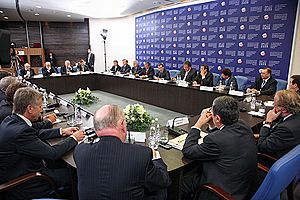
The Saint Petersburg International Economic Forum is a major Russian investment forum
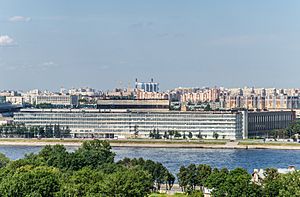
Power Machines plant building on Sverdlovskaya embankment in Saint Petersburg
Saint Petersburg is a major trade gateway, serving as the financial and industrial centre of Russia, with specializations in oil and gas trade; shipbuilding yards; aerospace industry; technology, including radio, electronics, software, and computers; machine building, heavy machinery and transport, including tanks and other military equipment; mining; instrument manufacture; ferrous and nonferrous metallurgy (production of aluminium alloys); chemicals, pharmaceuticals, and medical equipment; publishing and printing; food and catering; wholesale and retail; textile and apparel industries; and many other businesses. It was also home to Lessner, one of Russia's two pioneering automobile manufacturers (along with Russo-Baltic); it was founded by machine tool and boiler maker G.A. Lessner in 1904, with designs by Boris Loutsky, and it survived until 1910.
Ten per cent of the world's power turbines are made there at the LMZ, which built over two thousand turbines for power plants across the world. Major local industries are Admiralty Shipyard, Baltic Shipyard, LOMO, Kirov Plant, Elektrosila, Izhorskiye Zavody; also registered in Saint Petersburg are Sovkomflot, Petersburg Fuel Company and SIBUR among other major Russian and international companies.
Saint Petersburg has three large cargo seaports: Bolshoi Port Saint Petersburg, Kronstadt, and Lomonosov. International cruise liners have been served at the passenger port at Morskoy Vokzal on the south-west of Vasilyevsky Island. In 2008 the first two berths opened at the New Passenger Port on the west of the island. The new port is part of the city's "Marine Facade" development project and is due to have seven berths in operation by 2010.
A complex system of riverports on both banks of the Neva River are interconnected with the system of seaports, thus making Saint Petersburg the main link between the Baltic Sea and the rest of Russia through the Volga-Baltic Waterway.
The Saint Petersburg Mint (Monetny Dvor), founded in 1724, is one of the largest mints in the world, it mints Russian coins, medals and badges. Saint Petersburg is also home to the oldest and largest Russian foundry, Monumentskulptura, which made thousands of sculptures and statues that now grace public parks of Saint Petersburg, as well as many other cities. Monuments and bronze statues of the Tsars, as well as other important historic figures and dignitaries, and other world-famous monuments, such as the sculptures by Peter Clodt von Jürgensburg, Paolo Troubetzkoy, Mark Antokolsky, and others, were made there.
In 2007, Toyota opened a Camry plant after investing 5 billion roubles (approx. 200 mln dollars) in Shushary, one of the southern suburbs of Saint Petersburg. Opel, Hyundai and Nissan have also signed deals with the Russian government to build their automotive plants in Saint Petersburg. Automotive and auto-parts industry is on the rise there during the last decade.
Saint Petersburg has a large brewery and distillery industry. Known as Russia's "beer capital" due to the supply and quality of local water, its five large breweries account for over 30% of the country's domestic beer production. They include Europe's second largest brewery Baltika, Vena (both operated by BBH), Heineken Brewery, Stepan Razin (both by Heineken) and Tinkoff brewery (SUN-InBev).
The city's many local distilleries produce a broad range of vodka brands. The oldest ones is LIVIZ (founded in 1897). Among the youngest is Russian Standard Vodka introduced in Moscow in 1998, which opened in 2006 a new $60 million distillery in Petersburg (an area of 30,000 m2 (320,000 sq ft), production rate of 22,500 bottles per hour). In 2007 this brand was exported to over 70 countries.
Saint Petersburg has the second largest construction industry in Russia, including commercial, housing and road construction.
Cityscape
Palace Square in winter.
Winter Palace, Alexander Column, General staff Building
Saint Petersburg has three skyscrapers: Leader Tower (140 m), Alexander Nevsky (124 m) and Atlantic City (105 m) all far from the historical centre. Regulations forbid construction of tall buildings in the city centre. The 310-meter (1,020 ft) tall Saint Petersburg TV Tower is the tallest completed structure in the city. However, there was a controversial project endorsed by the city authorities, and known as the Okhta Center, to build a 396 meters (1,299 ft)
supertall skyscraper. In 2008, the World Monuments Fund included the Saint Petersburg historic skyline on the watch list of the 100 most endangered sites due to the expected construction, which threatens to alter it drastically. The Okhta Center project was cancelled at the end of 2010 and the
Lakhta Center project began in the city's outskirts. The complex will include 463-metre-tall (1,519-foot) office skyscraper and several low rise mixed use buildings. The Lakhta Center project has caused much less controversy and, unlike the previous unbuilt project, is not seen by
UNESCO as a potential threat to the city's cultural heritage because it is far from the historical centre. Skyscraper construction has started, and the building is set to be completed in 2018. It is assumed the building will be the tallest in Russia and Europe.
Unlike in Moscow, the historic architecture of Saint Petersburg's city centre, mostly
Baroque and neoclassical buildings of the 18th and 19th centuries, has been largely preserved; although a number of buildings were demolished after the Bolsheviks' seizure of power, during the
Siege of Leningrad and in recent years. The oldest of the remaining building is a wooden house built for
Peter I in 1703 on the shore of the Neva near Trinity Square. Since 1991 the Historic Centre of Saint Petersburg and Related Groups of Monuments in Saint Petersburg and Leningrad Oblast have been listed by
UNESCO as a
World Heritage Site.
The ensemble of Peter and Paul Fortress with the Peter and Paul Cathedral takes a dominant position on Zayachy Island along the right bank of the
Neva River. Each noon a cannon fires a blank shot from the fortress. The Saint Petersburg Mosque, the largest mosque in Europe when opened in 1913, is on the right bank nearby. The Spit of Vasilievsky Island, which splits the river into two largest armlets, the Bolshaya Neva and Malaya Neva, is connected to the northern bank (Petrogradsky Island) via the Exchange Bridge and occupied by the Old Saint Petersburg Stock Exchange and Rostral Columns. The southern coast of Vasilyevsky Island along the Bolshaya Neva features some of the city's oldest buildings, dating from the 18th century, including the Kunstkamera, Twelve Collegia, Menshikov Palace and Imperial Academy of Arts. It hosts one of two campuses of Saint Petersburg State University.
On the southern, left bank of the Neva, connected to the spit of Vasilyevsky Island via the Palace Bridge, lie the Admiralty building, the vast
Hermitage Museum complex stretching along the Palace Embankment, which includes the baroque
Winter Palace, former official residence of Russian emperors, as well as the neoclassical Marble Palace. The
Winter Palace faces Palace Square, the city's main square with the Alexander Column. Nevsky Prospekt, also on the left bank of the Neva, is the city's main avenue. It starts at the
Admiralty and runs eastwards next to Palace Square. Nevsky Prospekt crosses the Moika (Green Bridge), Griboyedov Canal (Kazansky Bridge), Garden Street, the Fontanka (Anichkov Bridge), meets Liteyny Prospekt and proceeds to Uprising Square near the Moskovsky railway station, where it meets Ligovsky Prospekt and turns to the Alexander Nevsky Lavra. The Passage, Catholic Church of St. Catherine, Book House (former Singer Manufacturing Company Building in the
Art Nouveau style), Grand Hotel Europe, Lutheran Church of Saint Peter and Saint Paul, Great Gostiny Dvor, Russian National Library, Alexandrine Theatre behind Mikeshin's statue of
Catherine the Great, Kazan Cathedral, Stroganov Palace, Anichkov Palace and Beloselsky-Belozersky Palace are all along that avenue.
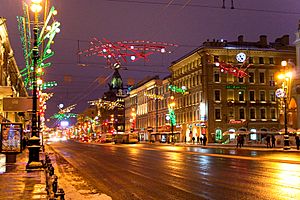
Nevsky Prospect at Christmas.
The Alexander Nevsky Lavra, intended to house the relics of
St. Alexander Nevsky, is an important centre of
Christian education in Russia. It also contains the Tikhvin Cemetery with graves of many notable Petersburgers. On the territory between the Neva and Nevsky Prospekt the Church of the Savior on Blood, Mikhailovsky Palace housing the Russian Museum, Field of Mars, St. Michael's Castle, Summer Garden, Tauride Palace, Smolny Institute and Smolny Convent are located.
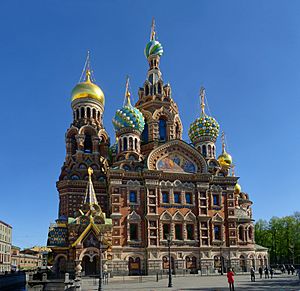
Church of the Savior on Blood
Many notable landmarks are to the west and south of the Admiralty Building, including the Trinity Cathedral, Mariinsky Palace, Hotel Astoria, famous
Mariinsky Theatre, New Holland Island, Saint Isaac's Cathedral, the largest in the city, and Senate Square, also known as Decembrist's Square with the Bronze Horseman, 18th century equestrian monument to
Peter the Great, which is considered among the city's most recognisable symbols.
Other symbols of Saint Petersburg include the weather vane in the shape of a small ship on top of the Admiralty's golden spire and the golden angel on top of the Peter and Paul Cathedral. The Palace Bridge drawn at night is yet another symbol of the city.
Every night during the navigation period from April to November, 22 bridges across the Neva and main canals are drawn to let ships pass in and out of the Baltic Sea according to a schedule. It was not until 2004 that the first high bridge across the Neva, which does not need to be drawn, Big Obukhovsky Bridge, was opened. There are hundreds of smaller bridges in Saint Petersburg spanning numerous canals and distributaries of the Neva, some of the most important of which are the Moika, Fontanka, Griboyedov Canal, Obvodny Canal, Karpovka and Smolenka. Due to the intricate web of canals, Saint Petersburg is often called
Venice of the North. The rivers and canals in the city centre are lined with granite embankments. The embankments and bridges are separated from rivers and canals by
granite or
cast iron parapets.
Southern suburbs of the city feature former imperial residences, including Petergof, with majestic fountain cascades and parks,
Tsarskoe Selo, with the baroque
Catherine Palace and the neoclassical
Alexander Palace, and Pavlovsk, which has a domed palace of Emperor Paul and one of Europe's largest English-style parks. Some other residences nearby and making part of the world heritage site, including a castle and park in Gatchina, actually belong to Leningrad Oblast rather than Saint Petersburg. Another notable suburb is Kronstadt with its 19th-century fortifications and naval monuments, occupying the Kotlin Island in the Gulf of Finland.
Since around the end of the 20th century a great deal of active building and restoration works have been carried out in a number of the city's older districts. The authorities have recently been compelled to transfer the ownership of state-owned private residences in the city centre to private lessors. Many older buildings have been reconstructed to allow their use as apartments and penthouses.
Some of these structures, such as the Saint Petersburg Commodity and Stock Exchange have been recognised as town-planning errors.
Tourism
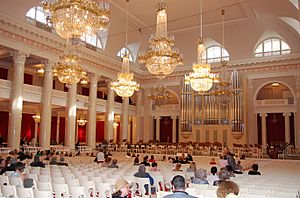
The Bolshoi Zal (Grand Hall) of Saint Petersburg Philharmonia.
Saint Petersburg has a significant historical and cultural heritage.
The 18th and 19th century architectural ensemble of the city and its environs is preserved in virtually unchanged form. For various reasons (including large-scale destruction during World War II and construction of modern buildings during the postwar period in the largest historical centres of Europe), Saint Petersburg has become a unique reserve of European architectural styles of the past three centuries. Saint Petersburg's loss of capital city status helped it retain many of its pre-revolutionary buildings, as modern architectural 'prestige projects' tended to be built in Moscow; this largely prevented the rise of mid-to-late-20th century architecture and helped maintain the architectural appearance of the historic city centre.
Saint Petersburg is inscribed on the UNESCO World Heritage list as an area with 36 historical architectural complexes and around 4000 outstanding individual monuments of architecture, history and culture. New tourist programs and sightseeing tours have been developed for those wishing to see Saint Petersburg's cultural heritage.
The city has 221 museums, 2000 libraries, more than 80 theatres, 100 concert organizations, 45 galleries and exhibition halls, 62 cinemas and around 80 other cultural establishments. Every year the city hosts around 100 festivals and various competitions of art and culture, including more than 50 international ones.
Despite the economic instability of the 1990s, not a single major theatre or museum was closed in Saint Petersburg; on the contrary many new ones opened, for example a private museum of puppets (opened in 1999) is the third museum of its kind in Russia, where collections of more than 2000 dolls are presented including 'The multinational Saint Petersburg' and Pushkin's Petersburg. The museum world of Saint Petersburg is incredibly diverse. The city is not only home to the world-famous Hermitage Museum and the Russian Museum with its rich collection of Russian art, but also the palaces of Saint Petersburg and its suburbs, so-called small town museums and others like the museum of famous Russian writer Dostoyevsky; Museum of Musical Instruments, the museum of decorative arts and the museum of professional orientation.
The musical life of Saint Petersburg is rich and diverse, with the city now playing host to a number of annual carnivals.
Ballet performances occupy a special place in the cultural life of Saint Petersburg. The Petersburg School of Ballet is named as one of the best in the world. Traditions of the Russian classical school have been passed down from generation to generation among outstanding educators. The art of famous and prominent Saint Petersburg dancers like Rudolf Nureyev, Natalia Makarova, Mikhail Baryshnikov was, and is, admired throughout the world. Contemporary Petersburg ballet is made up not only of traditional Russian classical school, but also ballets by those like Boris Eifman, who expanded the scope of strict classical Russian ballet to almost unimaginable limits. Remaining faithful to the classical basis (he was a choreographer at the Vaganova Academy of Russian Ballet), he combined classical ballet with the avant-garde style, and then, in turn, with acrobatics, rhythmic gymnastics, dramatic expressiveness, cinema, color, light, and finally with spoken word.
Images for kids
-
The Bronze Horseman, monument to Peter the Great
-
Map of Saint Petersburg, 1744
-
Street leading to St. Nicholas Naval Cathedral
-
Palace Square backed by the General staff arch and building; as the main square of the Russian Empire, it was the setting of many events of historic significance.
-
Decembrist revolt at the Senate Square, 26 December 1825
-
-
Citizens of Leningrad during the 872-day siege, in which more than one million civilians died, mostly from starvation. Nevsky Prospect
-
View of Lermontovski Prospekt, Egyptian Bridge and the Fontanka River, 1972
-
Griboedov Canal and the Church of the Saviour on Blood, 1991
-
View of the city from the Saint Isaac's Cathedral
-
Moyka River, flowing through Central Saint Petersburg
-
The Trinity Bridge is a landmark of Art Nouveau design.
-
Satellite image of Saint Petersburg and its suburbs
-
People walking on the main street of Saint Petersburg, Nevsky Prospekt
-
Life expectancy at birth in Saint Petersburg
-
-
-
-
-
Palace Square during Christmas
-
-
The "Temple of Friendship" in Pavlovsk Park
-
-
Grand Peterhof Palace and the Grand Cascade
-
Old Saint Petersburg Stock Exchange and Rostral Columns.
-
The main auditorium of the Mariinsky Theatre
-
Panorama of Stalls and Boxes at the Main Mariinsky Theatre.
-
Scarlet Sails celebration on the Neva River
-
The Alexandrinsky Theatre
-
-
Konstantin Khabensky, known for his roles in Night Watch, Day Watch and Admiral, is a native of Saint Petersburg.
-
-
A section of the Western High-Speed Diameter
-
Tram passing by Kronverksy Avenue
-
-
-
-
The Sapsan high-speed train runs between Saint Petersburg and Moscow.
-
Pulkovo International Airport
-
Cameron gallery in Catherine park of Tsarskoe Selo.
-
Grotto pavilion in Catherine park of Tsarskoe Selo
-
The Imperial Lyceum in Tsarskoye Selo.
-
-
The State Hermitage Museum is the largest art museum in the world by gallery space.
-
The State Russian Museum is the world's largest depository of Russian fine art.
-
The Russian Museum of Ethnography is one of the largest ethnographic museums in the world.
-
See also
 In Spanish: San Petersburgo para niños
In Spanish: San Petersburgo para niños


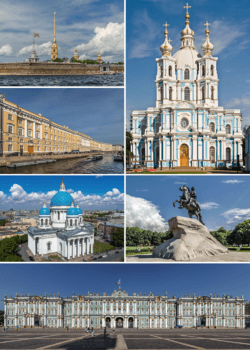


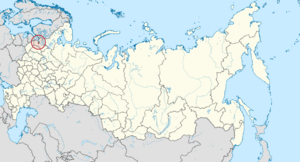
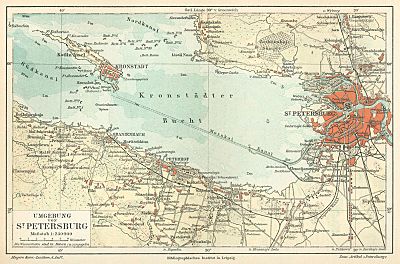






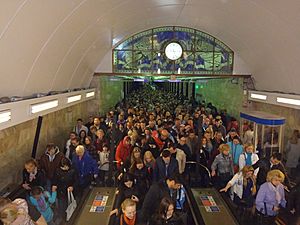

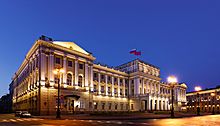
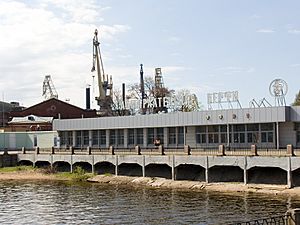



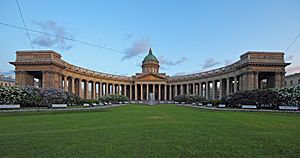
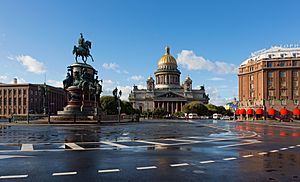
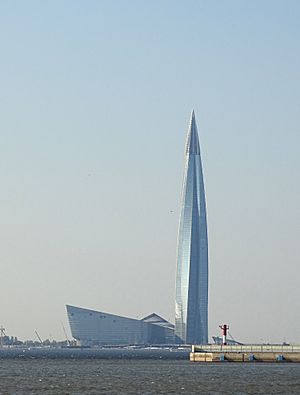
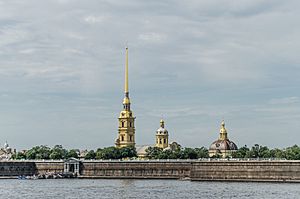

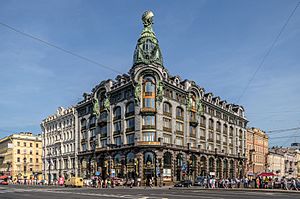

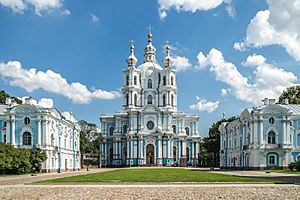
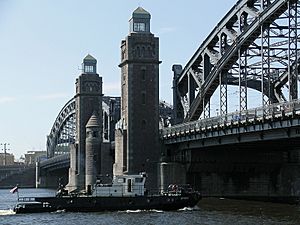

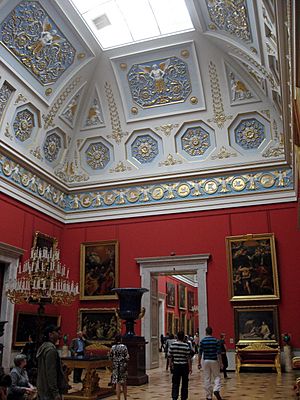












































 In Spanish:
In Spanish: